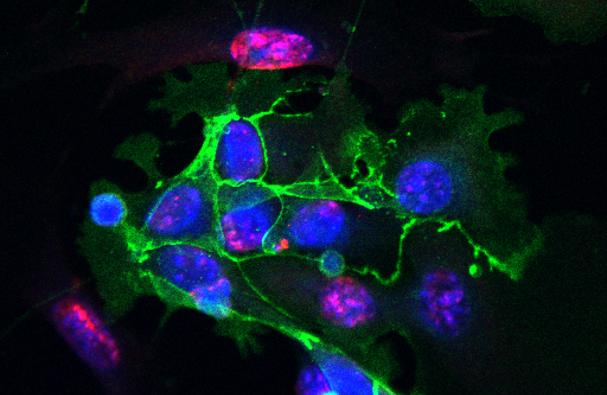Senolytic Drugs May Offer New IPF Therapy Options

Green cells show markers of the lung epithelium, red cells are undergoing senescence. The nuclei are stained in blue.
Recent studies have shown that idiopathic pulmonary fibrosis (IPF) may be caused by senescence, a cellular aging process. Now, a team of German researchers have successfully counteracted this mechanism in cell culture by using senolytic drugs that are able to kill senescent epithelial lung cells.
These findings were reported in a study titled “Senolytic drugs target alveolar epithelial cell function and attenuate experimental lung fibrosis ex vivo,” which was published in The European Respiratory Journal.
In IPF patients, the lung becomes unable to deal with fibrosis. As a result, extracellular factors accumulate, which causes scarring, destruction of lung architecture, and progressive loss of patient’s pulmonary function. The research team found molecular markers of cellular senescence in both the lung tissue of IPF patients and in animal models. Although senescent lung cells do not divide when they need to be replaced, they keep secreting pro-fibrotic signals.
“In both the experimental model and in the lungs of IPF patients, we were able to show that some cells in the alveolar epithelium have markers for senescence,” explained the study leader Melanie Königshoff, MD, PhD, in a press release. “Because the occurrence of IPF increases with age, this was already suspected. We have now succeeded in proving this hypothesis.”
The team cultured fibrotic mouse type II lung epithelial cells in a three-dimensional system. They found increased amounts of senescence-associated secretory phenotype (SASP) factors, which also are pro-fibrotic. However, they found that there was a reduction in the number of senescent cells and of SASP if they treated the cell culture with a combination of senolytic drugs (dasatinib and quercetin).
“We observed that this caused a decline in the quantity of secreted mediators and additionally a reduction in the mass of connective tissue proteins, which are greatly increased in the disease,” said Königshoff.
Although this study suggests senolytic drugs as a viable therapeutic option for IPF, results require confirmation in other models. “Future studies using in vivo models targeting specific senescent cell populations are needed to further delineate senescent cell-specific contribution to the development of pulmonary fibrosis. In addition, it will be important to further confirm the role of senescent cell types in human lung tissue,” wrote the authors in this study.






